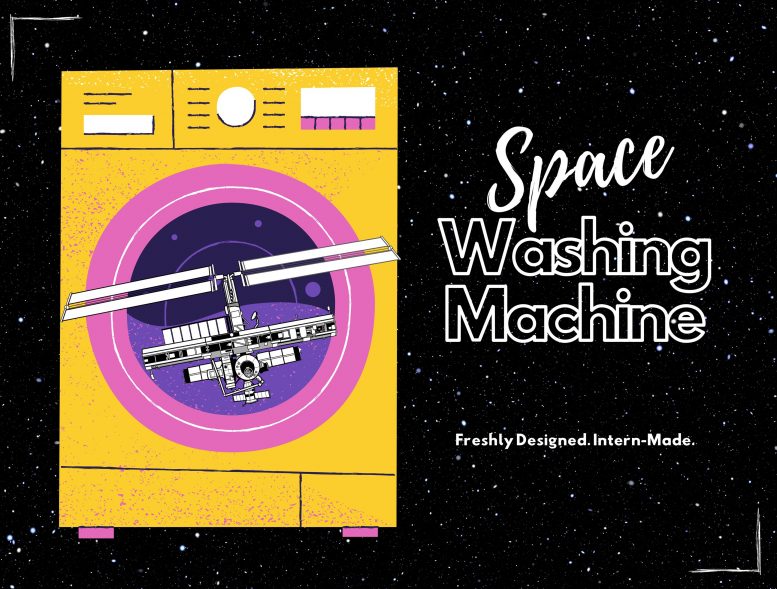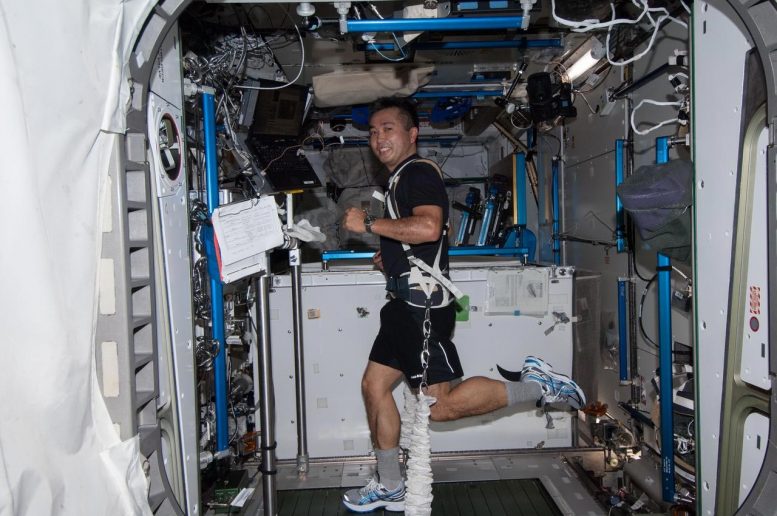
NASA Glenn interns brainstormed ways to wash clothes on the space station during a summer design challenge. Credit: NASA/Design by Ellen Bausback
There is no laundry in space… yet. Astronauts only bring two small suitcases-worth of clothes aboard the International Space Station, sometimes wearing the same pair of underwear for up to a week. And these used garments aren’t washed – they’re booted onto ships that burn up in the atmosphere.
At 
Japan Aerospace Exploration Agency astronaut Koichi Wakata exercises on the space station’s treadmill. While astronauts don’t dirty their clothes the same way we do on the ground, their clothes still get sweaty and soiled. Credit: NASA
Interns juggled cost, space, and resource concerns and even created their own acronyms. Here’s what they came up with:
Agitation Rollers Team- SLUSH (Screw-Like Undirtying Spinning Hardware)
Sophia DeSisto, Samuel Dwyer, Gabriel Morales, and mentor Rosa Padilla designed a spring-loaded corkscrew device that spins and pitches dirty clothes in microgravity. They won the overall Best Design Award and the Imagery Award for having the most useful and impressive design visuals.
Dirty Water Removal Rollers- DRUM (Drying Roller Ultra-Convenient Machine)
Suraju Lawal, Himshikha Nath, Mariam Shah, and mentor Gordon Berger designed a roller that uses magnets and capillary action to squeeze out excess water. They won the Innovators Award for showing the most creativity.
Control Systems Team- ArduWashers
Jonah Sachs-Wetstone, Letizia Moro, Joseph Shepard, and mentor Tyler Hatch created a control system using an Arduino microcontroller, a coding hardware found in some satellites. They won the Ready for Production award for most realistic and completely designed concept.
Soaking Rollers Team- G.L.E.N. (Galactic Laundry Equipment for AstroNauts)
Alex Drenth, Samantha Eason, Christina Brown, and mentors Claire Fortenberry and Cody Farinacci designed water-releasing tubes and a hooking mechanism for soaking clothes. They won the Speakers Bureau Award for best presentation skills.
Dirty Water Squeegee Team- WCU (Water Collection Unit)
Neoneela Boevets, Hunter Rehm, Victoria Blanc, and mentor Daniel Gotti designed a pair of rollers with bristled squeegees that use vacuum power to suck water into a triangular collection chamber. They won the Smart Shopper Award for best use of materials.
Disinfecting and Deodorizing Team- WASHING Machine (Wash And Sanitizing Habitat In No Gravity)
Thomas Placzkowski, Sarit Dhar, Garrett Pohlman, and mentor Monica Guzik created a chamber that incorporates a titanium dioxide coating, ultraviolet light, and ozone gas to sanitize laundry. They won the A.C.E.S. Award for best acronym.
The Design Cycle
Inspiration for the whirling agitation gadget struck Morales while daydreaming about the Slushie machine in his favorite childhood pizza joint. The fourth-year mechanical engineering undergraduate from the Polytechnic University of Puerto Rico said he loved the hands-on work.
“The experience is unmatched,” he said. “It gives you a more in-depth feel of what it actually is to work as an engineer.”
For Sarit Dhar, a second-year medical student from the University of Toledo, the best part of the challenge was designing the concept from scratch.
“I don’t usually get to do that anymore now that I’m in medical school – just being able to break out my sketchpad and draw something,” Dhar said.
Christina Brown, a second-year graduate student from the University of Houston College of Business, had never attempted a design challenge before and was thrilled the opportunity was open to all majors.
“I’ve gotten to push parts of my mind that I’ve never really used,” she said.
Collaborating with other interns was a plus for Samuel Dwyer, a fourth-year mechanical engineering undergraduate from Youngstown State University.
“It played right into our strengths,” he said. “Each person made the group work.”
Rinse and Repeat
This is the third intern design challenge hosted by NASA Glenn, according to internship coordinator Eric Hayes. The washing machine idea was scaled up from previous, simpler challenges geared toward high school students. NASA will likely expand the challenge to more students going forward.
Nancy Hall, consultant for the challenge and NASA fluid physics expert, said interns’ ideas could serve as a basis for future washing machine designs that would potentially launch into space.
“Students are very creative,” Hall said. “They don’t see the limitations we see.”
Hayes told participants he was impressed with their work.
“If you take over a lot of the seats at NASA one day, I’ll feel good about where we land,” Hayes said.